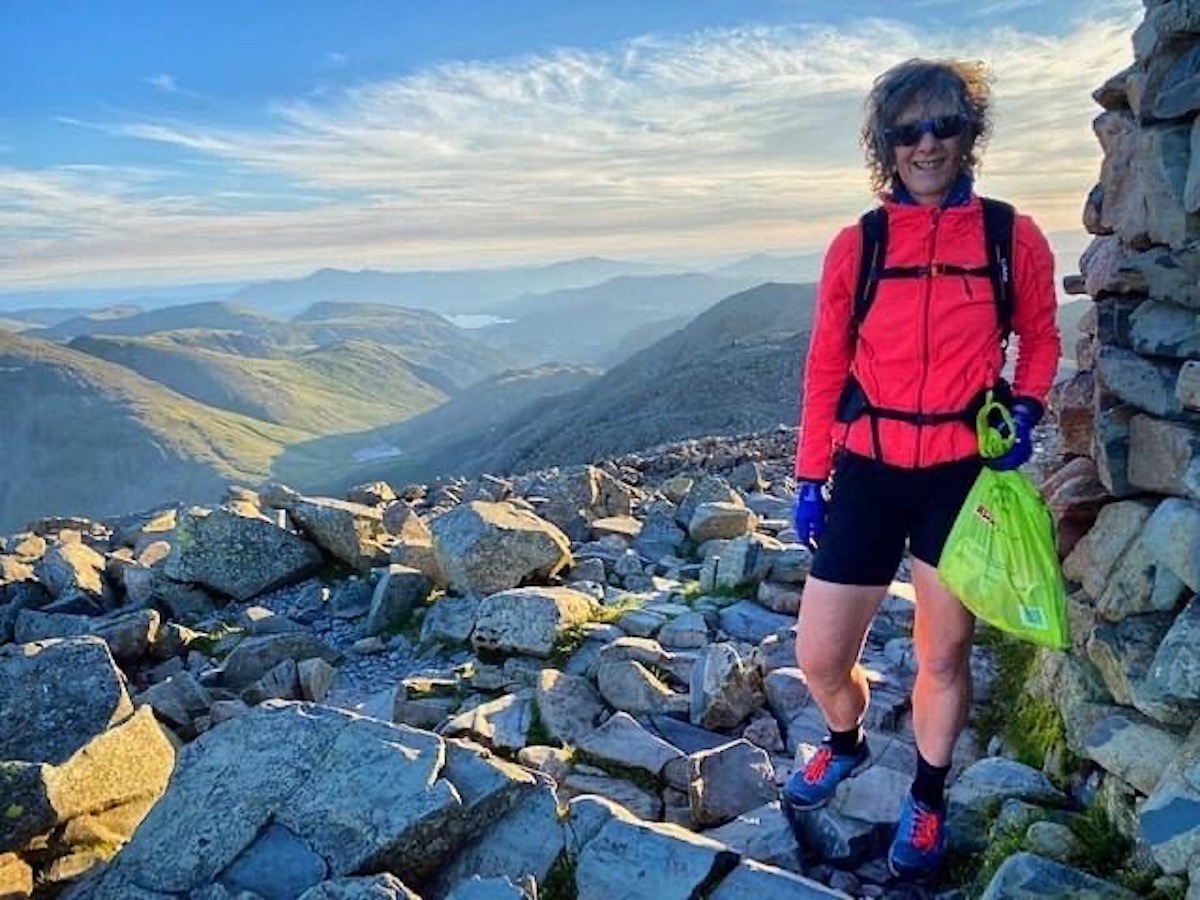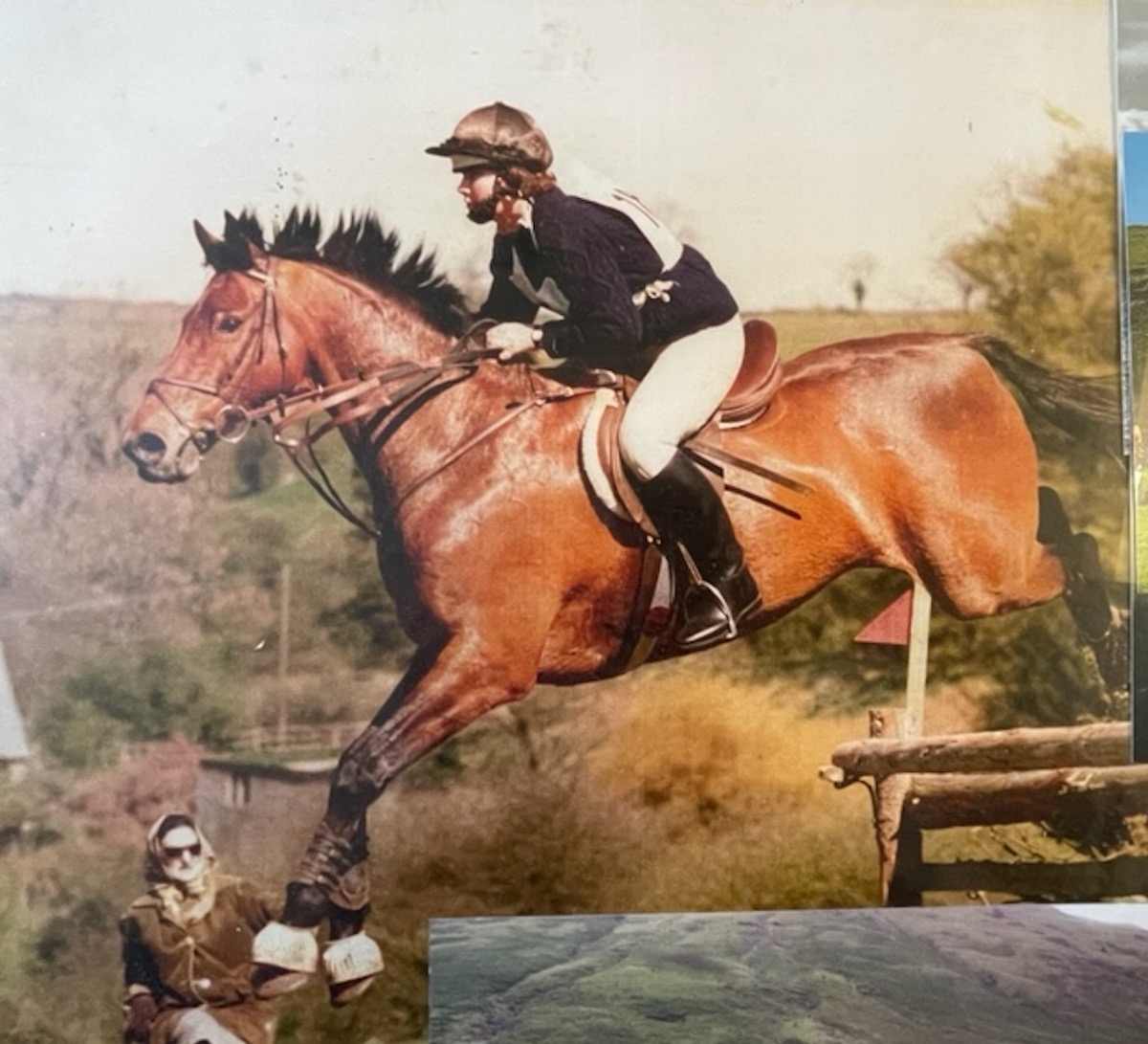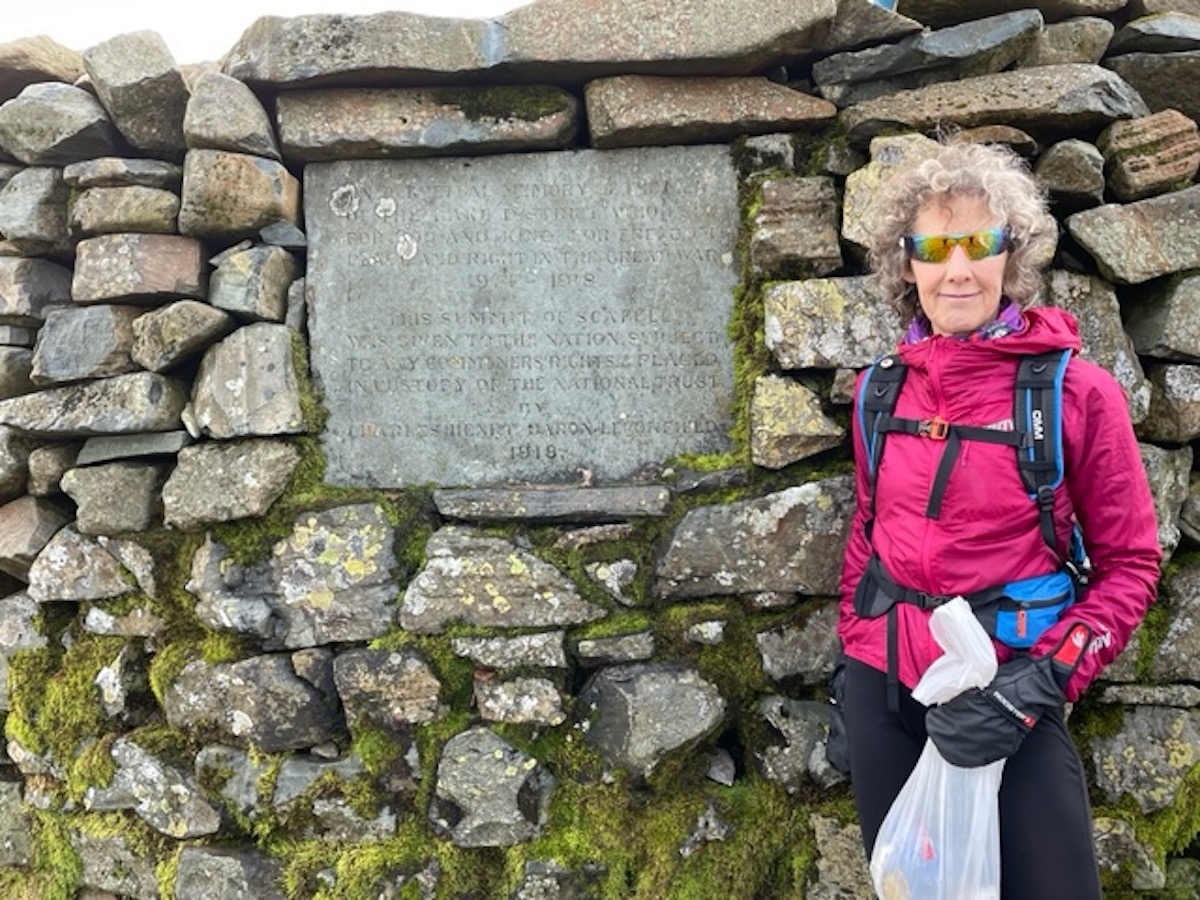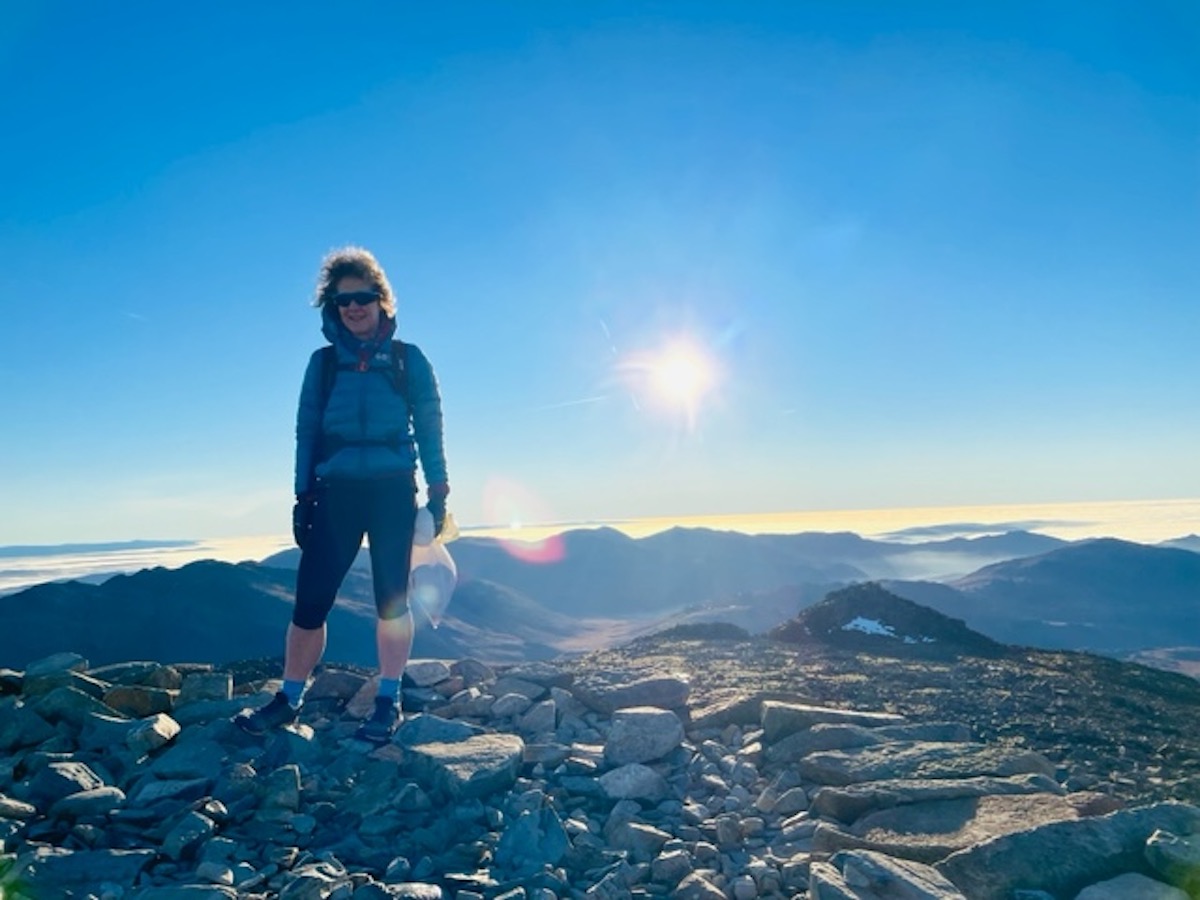Longtime fell runner Lindsay Buck grew up in Oxfordshire County in south-central England. “[It is] a very rural area without many hills,” she said. Buck moved to the Lake District in Cumbria County 27 years ago with her husband, Jim Davis, where she first found trail running.
Today, the retired horsewoman, nanny, and factory worker spends several days per week year-round picking up rubbish on the trail to the top of England’s highest peak, Scafell Pike. This combination of running and picking up trash is called “plogging,” the terminology sourced from a combination of the Swedish words “plocka upp” or pick up, and “jogga” or jog. Thus, plogging.
From her doorstep, 61-year-old Buck bikes eight miles one way to the base of the fell, and then climbs the route on foot. The mountain climb is a five-mile roundtrip jaunt with a 3,000-foot ascent, a climb that requires “a reasonable amount of effort,” according to Buck. Afterward, she bikes home with her bike basket full of the trash she’s snagged along the way.

Lindsay Buck collecting rubbish on a trail leading up to the fells in England. All photos courtesy of Lindsay Buck.
“I’ve always picked up litter, and we were always told [as kids] not to drop anything. Scafell Pike is a really popular fell. Lots of people go … and it suffers from [a large] amount of trash,” explained Buck. Hikers are enamored by Scafell Pike’s beauty, novelty, and summit war memorial. At the close of World War I, Scafell Pike and surrounding land above 2,000 feet were designated by Lord Leconfield, a British politician, as a memorial to the soldiers of the Lake District who served and died during the war.
“It’s a moving place to have a memorial, and that [is one of the reasons] it should be kept really clean for people when they visit,” said Buck. The memorial is a large stone cairn shaped into a hut with a memorial plaque on the side. The only way to reach the site is by foot.
When Buck retired a decade ago, she had seemingly unlimited time for plogging. “I have a very understanding husband who pays the bills,” said Buck, whose partner is a nuclear safety manager.
When the COVID-19 pandemic hit, public land needed the help of ploggers like Buck even more. “It’s always something I’ve done, but I never realized how much rubbish would be left on that fell, and with the release of the lockdown, the area has gotten even more popular. Most people are absolutely respectful, though a minority that travels up there is unfamiliar with [environmental concerns]. There are no [trash] bins, and they can leave a lot of mess. It’s a lot of work to keep it clean. [Scafell Pike] is my main focus for my plogging, and I use it as my fell training,” said Buck, who plogged along Scafell way more than 200 times in the past year. Occasionally, her husband joins her.
Some adventurers might perceive the roundtrip routine as repetitive, though Buck’s motivation never wanes. “I love going up the valley and up that particular fell. It’s a beautiful environment, quiet, wild, and meditative. I meet an eclectic mix of interesting people. It’s a mix of sociable [time] and solitude. I never get fed up with it, and I like the idea of leaving it clean,” Buck explained.
In a roundabout way, Buck started running in her early thirties in order to ride Arabian horses. “You need to be quite fit for [racing]. I rode as an amateur for fun, but running is much simpler and that’s what I carried on with,” she said.
When she signed up for the 1993 Paris to Versailles 10 Mile, a classic road race from the Eiffel Tower to the Palace of Versailles in France, she met Jim and moved to the Lake District the following year, where fell racing is very popular in the mountains. Her first fell race was in 1997: a nine-mile route with a 3,000-foot climb.
“I was a complete convert. I had done a lot of walking and that translates well, but I didn’t know the route, and it was a magical adventure. It was such good fun. I was in my late thirties in 1997,” she said.
In December of 2021, Buck raced her 1,000th fell race: the Stybarrow Dodd, a four-mile route with 2,300 feet of climbing on the fell of the same name. Her favorite races are ascents. She typically races twice per week in the summer and a bit less in the winter.
“My goal is to run as long as I possibly can. Fell races are very different than trail races, because they are not marked routes. If the mist is down, you have to find your way with a waterproof map and compass. We need to navigate, which levels the competition a bit. I’m slow to start with and I’m in the back and everyone is good friends,” says Buck.
GPS devices are not permitted during fell races. “Most fell races ban electronic help. If you use it as backup, you declare yourself noncompetitive. That was an integral part of the sport. Consider if you [don’t use your] phone — you’re back to the old-fashioned way of getting to know your way of moving around.”
Buck always carries a whistle, map, and compass, but no satellite communication device on her fell runs. On any given day, the weather is sunny, windy, snowy, or rainy — and she always goes. She’s prepared with the suitable gear, but isn’t afraid to turn around if the conditions get hairy. The conditions can vary dramatically from the bottom of the fell to the top, and the weather can roll in fast, changing completely within 10 minutes.
“Our local Wasdale Mountain Rescue Team has been really busy. The last thing I want is to put them in a bad position,” Buck shared.
Classic navigation works well for Buck, who doesn’t own a cellphone or have an email address. She borrows Jim’s cellphone to post photos of plogging to Facebook to help educate and inspire others to help keep these precious landscapes clean. “If they came across it and thought it’s clean, they’d think the fairies did it,” she laughs.
On a daily plog, Buck carries a gallon-sized garbage bag and cut-resistant gloves. After her Scafell descent, she separates the recyclables to bring home and leaves landfill items with the National Trust in the valley, a 125-year-old conservation charity that works to protect England’s nature and history; from the coastline and woodlands to the countryside, gardens, and historic buildings. The organization, which owns the land at the top end of the valley, oversees the Lake District and Scafell Pike.
Buck donates the aluminum cans to the local air ambulances, which can be used to collect cash for the charity. She washes clothing and donates it to the proper local charity or person in need.
“I found a dog coat in the stream before last Christmas, which got washed and given to a local dog-walking lady,” she says. With everything from cameras to children’s shoes, she’ll make social media posts or use word of mouth to find the owner. If the item isn’t claimed, it is donated.
Buck isn’t the only one aiding the grassroots effort. Locally, a dozen or so folks independently and regularly pick up trash. Some clean the roadsides near their home. One farmer clears up a segment of road from the cattle grid to his property line. As a former nanny, Buck knows a lot of youngsters who plog.
Mick Pearce, another local, independently plogs up Scafell Pike too. “He’s passionate and really committed to keeping it clean. We keep in touch about what [peaks] we’ve been up and [what we’ve] found. All the ploggers go independently and share where we went and support each other, knowing that there’s someone out there, not feeling alone. It’s good to keep in touch with like-minded people from all over the place,” Buck said.
Even a little bit of help to pick up rubbish goes a long way. “I hope everyone can do their part, even if it’s one piece and you’re busy, it’s one less piece for everyone to see a mess. It’s a really positive thing to do. My sister now picks in her local village. Everyone could just do a little bit, and it makes quite a big difference. It is a bit of an obsession, but a healthy one. I hope it’s good for the planet.”
Lindsay’s final total for Skafell Pike plogging ascents in 2021 was 243. That’s well over 200 days of helping make her backyard — and the world — a greater place for everyone to enjoy.
Call for Comments
- Have you seen Lindsay Buck or others plogging on or around Scafell Pike, or have you been the beneficiary of her work as you scaled the clean mountain?
- Do you take part in any trash or rubbish collection to keep your local open spaces clean? If so, share your story of doing so.




